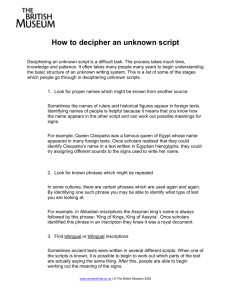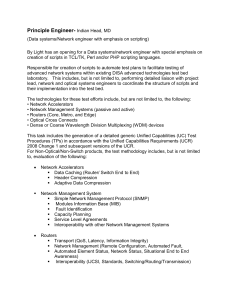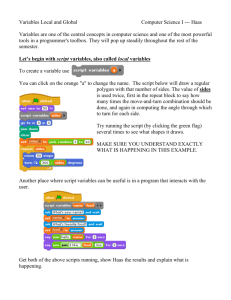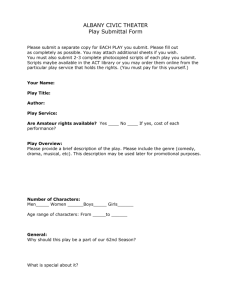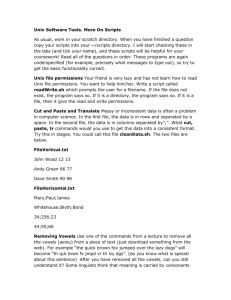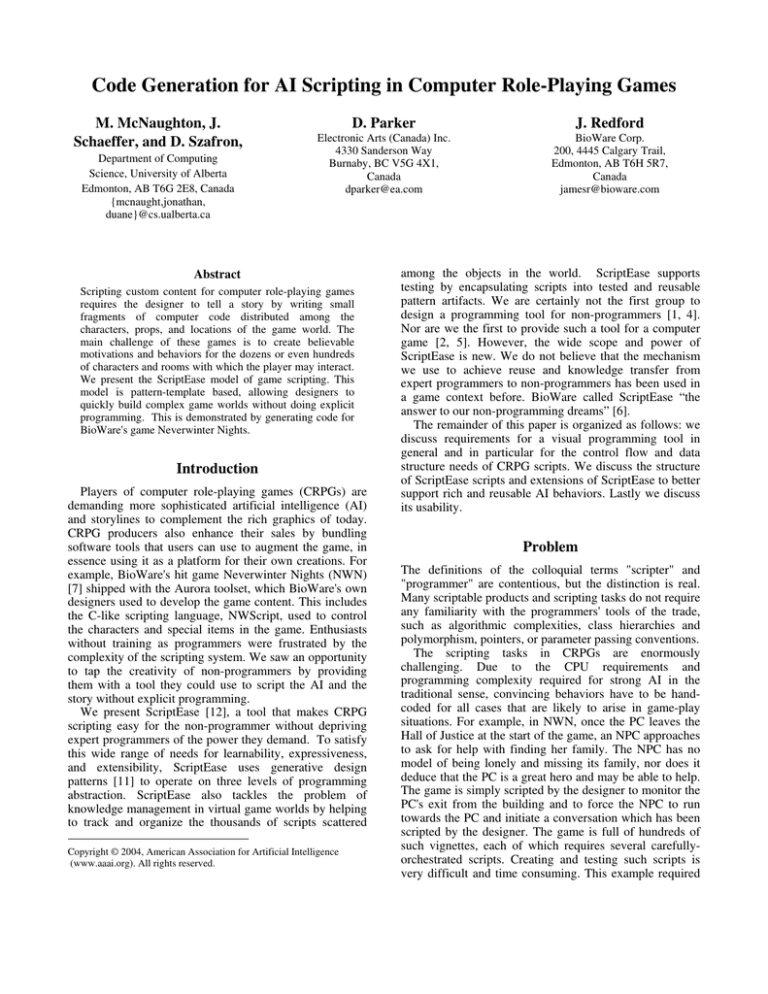
Code Generation for AI Scripting in Computer Role-Playing Games
M. McNaughton, J.
Schaeffer, and D. Szafron,
Department of Computing
Science, University of Alberta
Edmonton, AB T6G 2E8, Canada
{mcnaught,jonathan,
duane}@cs.ualberta.ca
D. Parker
Electronic Arts (Canada) Inc.
4330 Sanderson Way
Burnaby, BC V5G 4X1,
Canada
dparker@ea.com
Abstract
Scripting custom content for computer role-playing games
requires the designer to tell a story by writing small
fragments of computer code distributed among the
characters, props, and locations of the game world. The
main challenge of these games is to create believable
motivations and behaviors for the dozens or even hundreds
of characters and rooms with which the player may interact.
We present the ScriptEase model of game scripting. This
model is pattern-template based, allowing designers to
quickly build complex game worlds without doing explicit
programming. This is demonstrated by generating code for
BioWare's game Neverwinter Nights.
Introduction
Players of computer role-playing games (CRPGs) are
demanding more sophisticated artificial intelligence (AI)
and storylines to complement the rich graphics of today.
CRPG producers also enhance their sales by bundling
software tools that users can use to augment the game, in
essence using it as a platform for their own creations. For
example, BioWare's hit game Neverwinter Nights (NWN)
[7] shipped with the Aurora toolset, which BioWare's own
designers used to develop the game content. This includes
the C-like scripting language, NWScript, used to control
the characters and special items in the game. Enthusiasts
without training as programmers were frustrated by the
complexity of the scripting system. We saw an opportunity
to tap the creativity of non-programmers by providing
them with a tool they could use to script the AI and the
story without explicit programming.
We present ScriptEase [12], a tool that makes CRPG
scripting easy for the non-programmer without depriving
expert programmers of the power they demand. To satisfy
this wide range of needs for learnability, expressiveness,
and extensibility, ScriptEase uses generative design
patterns [11] to operate on three levels of programming
abstraction. ScriptEase also tackles the problem of
knowledge management in virtual game worlds by helping
to track and organize the thousands of scripts scattered
Copyright © 2004, American Association for Artificial Intelligence
(www.aaai.org). All rights reserved.
J. Redford
BioWare Corp.
200, 4445 Calgary Trail,
Edmonton, AB T6H 5R7,
Canada
jamesr@bioware.com
among the objects in the world. ScriptEase supports
testing by encapsulating scripts into tested and reusable
pattern artifacts. We are certainly not the first group to
design a programming tool for non-programmers [1, 4].
Nor are we the first to provide such a tool for a computer
game [2, 5]. However, the wide scope and power of
ScriptEase is new. We do not believe that the mechanism
we use to achieve reuse and knowledge transfer from
expert programmers to non-programmers has been used in
a game context before. BioWare called ScriptEase “the
answer to our non-programming dreams” [6].
The remainder of this paper is organized as follows: we
discuss requirements for a visual programming tool in
general and in particular for the control flow and data
structure needs of CRPG scripts. We discuss the structure
of ScriptEase scripts and extensions of ScriptEase to better
support rich and reusable AI behaviors. Lastly we discuss
its usability.
Problem
The definitions of the colloquial terms "scripter" and
"programmer" are contentious, but the distinction is real.
Many scriptable products and scripting tasks do not require
any familiarity with the programmers' tools of the trade,
such as algorithmic complexities, class hierarchies and
polymorphism, pointers, or parameter passing conventions.
The scripting tasks in CRPGs are enormously
challenging. Due to the CPU requirements and
programming complexity required for strong AI in the
traditional sense, convincing behaviors have to be handcoded for all cases that are likely to arise in game-play
situations. For example, in NWN, once the PC leaves the
Hall of Justice at the start of the game, an NPC approaches
to ask for help with finding her family. The NPC has no
model of being lonely and missing its family, nor does it
deduce that the PC is a great hero and may be able to help.
The game is simply scripted by the designer to monitor the
PC's exit from the building and to force the NPC to run
towards the PC and initiate a conversation which has been
scripted by the designer. The game is full of hundreds of
such vignettes, each of which requires several carefullyorchestrated scripts. Creating and testing such scripts is
very difficult and time consuming. This example required
nine scripts distributed between the NPC, an invisible
tripwire drawn on the floor, and the dialog file attached to
the NPC. The capabilities of the AI are limited by the
immense amount of time it takes to create and test scripts.
Our approach manages this complexity and provides
infrastructure that will support AI. NPC characters will be
able to learn, remember events in the game, and have rich
behaviors.
The NWScript Language
NWScript is a C-like scripting language used by NWN to
control everything from the NPCs’ behaviors and the
storyline of the game to weather changes and lighting
effects. Notably missing are pointers and full support for
aggregate data structures like C structs and arrays. Longterm data is stored in string-indexed dictionaries attached
to game objects. Aurora provides NWScript with an
interface to the game engine through a set of library
functions. The game's execution model is event-driven.
Scripts run in response to events in the game world. When
a particular event occurs, its associated script executes.
Scripts that do not terminate in a fixed number of virtual
machine instructions are forcibly aborted. Almost every
object in the game has a set of events associated with it.
For example, creatures recognize 12 events, such as when
its way is blocked, when it is attacked, and when it sees
something new. Other objects like furniture, rooms, and
doors have scriptable events as well. Notably,
conversations can have scripts attached. A conversation is
a tree of all things an NPC character could say to a PC, and
all responses the PC could choose from. Not all nodes are
appropriate given the state of the storyline and the
circumstances, so a script may be attached to a
conversation node to control whether it may be said. Also,
a script may be run when a conversation node is uttered ingame, either by an NPC or by the PC.
Every object has a first-in-first-out action queue, which
contains all of the actions it is supposed to execute.
Actions are removed from the head of the queue and
executed. An action can be something like walking to a
target location, commencing an attack, opening a chest, or
resting for a while. The scripting language is capable of
modifying an action queue by either clearing it,
temporarily locking it so new actions cannot be added, or
adding new actions to the end. The ability to have a
callback fire when an action is cleared or completed would
be a welcome addition.
User Requirements
To determine the capabilities ScriptEase would require, we
looked at the approximately 2000 scripts in "Chapter 1" of
the campaign that shipped with NWN to find recurring
patterns of control-flow structure, patterns of variable use,
and any often-used set of scripts. Most scripts are only a
few lines long. We also looked at the questions asked by
non-programmers in the NWN scripting web forum [8]
hosted by BioWare to determine what kinds of conceptual
difficulties people have with programming. The typical
conceptual and practical roadblocks were problems like:
• What is a variable?
• What kind of brackets should I use?
• Why doesn’t my script compile?
There are many others as well. A typical approach by a
non-programmer attempting to write a script is to request
script fragments on the forum or to browse through
libraries of scripts that are all but finished and only require
customizing a few parameters. A non-programmer who is
trying hard can often identify the parts of a script that need
to be changed, but if a combination of portions of different
scripts is required to get a custom set of effects the task
may become too difficult.
We saw that the requests for scripts by nonprogrammers could usually be filled by scripts having a
few simple properties:
• They never need to assign a variable one value
and then assign it a different value later.
• If the control path branches at a conditional, one
branch usually exits immediately.
• If the branch doesn't exit immediately, it doesn't
rejoin the other path until the end of the script.
• Loops are rarely needed. When they are, they
typically iterate over all game objects satisfying a
simple predicate, then either: stop upon finding
the first one satisfying some further predicate, or
perform a simple action on all of them. Nested
loops are very rare.
What users need are small code fragments requiring some
customization by different parameters, and to know where
to put the fragment. We observed that when
knowledgeable programmers respond to requests for help,
they typically do so with insufficient detail for a nonprogrammer. For example, they may give just a fragment
of a script, or a just a function name, each requiring the
recipient to customize it appropriately by substituting
parameters or knowing how to invoke the function with the
arguments in the correct order.
Our major contribution with ScriptEase is the
formalization of this knowledge transfer process.
ScriptEase allows programmers to package their
knowledge into code fragments that formally describe their
data and control inputs and outputs. For the user who just
wants a simple script to do a simple task, this is more
powerful than any amount of clear commenting and prose
exposition. ScriptEase makes it impossible for the end
user to make a syntax error. Only syntactically correct
statements can be made. Put another way, ScriptEase
enables encapsulation of code at very fine levels of
abstraction.
We've come up with important functional requirements
for the user interface (UI), but in this paper our focus is the
model of reusable AI code fragments, not UI
implementation. Briefly, the concepts of variables, and
parameter aliasing are tricky. Models of AI code fragment
reusability exist [9]. These models depend on emergent
properties of the behavior model to make convincing
backdrops to the story, and to fill in the space with "extras"
Figure 1 - Main ScriptEase Window
in movie parlance. This is not good enough to carry a
story. Our challenge is to integrate AI with the plot
constraints of an interactive story in a tool usable by nonprogrammers. Believable NPCs can have a wide variety of
behaviors. However, when a game designer's desires for
how the story should unfold are taken into account, the
challenge of integrating AI with story requirements is
difficult. ScriptEase attempts to meet this challenge.
The user builds the module in the Aurora toolset by
picking objects from a palette and painting them on the
ground. Once all of the objects have been created and
placed, the user closes the toolset and starts ScriptEase.
•
•
•
Figure 1 contains a Situation, marked with an “S” icon and
labelled "Enter perimeter - add actions". The Situation is
composed of a linear sequence of executable atoms.
•
Structure of ScriptEase
The traditional script is mirrored by the Situation in
ScriptEase. A Situation is composed of components called
Atoms, which are encapsulated pieces of scripting code.
ScriptEase constrains the user to combine Atoms in
syntactically valid ways. ScriptEase has five types of
Atom:
•
•
Event atoms, describing the types of events in
the game to which scripts may fire in response.
Action atoms, which wrap code that can be used
to change the game world.
Definition atoms, which wrap code for gathering
information about the game world.
Condition atoms, which use information about
the game world to direct the control flow of the
Situation.
Option atoms, which encapsulate enumeration
types in the game engine API.
•
An Event atom which says when the Situation
may execute, and introduces relevant game
entities to the scope. For example, an event may
fire a script whenever any creature enters a
polygonal area (called a perimeter). In the
example of Figure 1, the event is the node marked
with a V icon, “When a creature enters The
Perimeter”. The event provides the rest of the
Situation with information like the identities of
the Active Perimeter and the creature that entered
it. These take the form of Definition atoms,
described next.
An optional sequence of Definition atoms
gathering more information about the game
world. In the example, the event contains its own
•
•
read-only Definition, and the user has added
another one, “Define Has Item…”, right after the
event.
An optional sequence of Condition atoms
performing Boolean tests on the information
gathered by previous atoms. Tests with a false
result cause the Situation to stop executing.
An optional sequence of Actions that manipulate
the game world. The current version of ScriptEase
has simple Action atoms and Complex Actions.
A Complex Action is a parameterized sequence of
other actions. It can be manipulated just like an
atom, or expanded, and its internals modified by a
non-programmer, unlike an action atom. An
Action atom may introduce game entities into the
scope. For example, an action that spawns a new
creature in the game can make it available as a
parameter to the actions following.
The Situation has a linear control flow starting at the
Event and flowing down through the Definitions,
Conditions, and Actions. Note that a Definition is just a
special case of an Action that must introduce an entity and
is prohibited from having side effects in the game (though
there is no mechanism for enforcing this). We chose to
restrict the Situation to a single linear flow of control not
only for simplicity of implementation in the UI but also
because more complex flow is confusing for the audience
we are trying to reach.
Now we discuss the structure of atoms in detail before
moving on to Encounter Patterns. The Action atom has:
•
•
•
•
•
A name which briefly tells what the Action does.
This name is displayed in the menu of available
actions when the user is building a script.
The entities that the action introduces to its scope,
either by creating them or retrieving handles to
them, with their default label strings.
A list of named parameters and their types. These
are one-to-one with the parameters to the
underlying function call.
A "specific description" which contains text
substitution codes that are replaced with actual
parameter values of the action. For example, an
action atom called "Assign XP to a creature" has
two parameters: the creature to receive the XP,
and the quantity of XP assigned. The specific
description is "Assign <p2> to <p1>". In Figure
1, we can see that the specialized description of
this instance of the atom is "Assign 50 XP to
Enterer”.
The function name and scripting code body that
actually implements the action's semantics in the
game engine's scripting language.
The other atom types, barring Option atoms, have a
similar set of properties. Atoms are constructed by a
skilled programmer. Option atoms are minor pieces of
glue, being just a list of the underlying code symbols and
English descriptions of same.
ScriptEase patterns are offered in two forms, the
Encounter Pattern and the Complex Action. The Complex
Action contains a sequence of actions and a list of
parameters available to those actions. After instantiating a
Complex Action, the user can set the parameters and edit
the action list however desired. Figure 1 shows a Complex
Action labelled "Then, Animate Defaced Statue..." that the
user has added to the script. The top-level node for the
Complex Action (CA) is shown selected, and the tabs in
the bottom pane are properties for the CA. The
"Description" tab contains documentation on the purpose
and use of this CA, and the remaining tabs are parameters
to the CA. This CA turns a "placeable" ("Target") (in
NWN, essentially a piece of furniture like a chest or a
statue) into a creature ("Creature Blueprint") while
showing a flashy visual effect ("Impact Effect") and makes
it attack someone ("Attacked"). In Figure 1 the Attacked
parameter tab is selected. The user can choose parameter
values from two sources. "Module Blueprint" allows the
user to select a statically placed entity in the game module.
"Select Creature" has the user select a game object
introduced dynamically by a preceding atom. Here, the
only creature in scope is "Enterer", introduced by the
Event as the creature that crossed “The Perimeter”. “The
Perimeter” is a parameter of the "Item perimeter"
Encounter pattern, the node marked with an "E" icon
above the Situation node.
The Encounter Pattern is similar in spirit to the Complex
Action. Like the Complex Action, it has a list of
parameters available to its components. The difference is
that it has a list of Situations rather than Actions. After
instantiation, the parameters can likewise be set and the
Situations edited however desired. Encounter Patterns let
the user quickly fill out the details of common scripted
interactions that recur through RPGs. These recurring
patterns are not limited to NWN. For example:
• “Spell request conversation” lets the user quickly
script a conversation that allows the PC to request
spell casting services from an NPC.
• “Automatically close and lock door” generates
scripts for a door that closes and locks itself.
• “Barrier perimeter” generates scripts for an
invisible force field.
Encounter Patterns have options for common variants
and can be augmented with functionality unforeseen by the
designer.
An advanced non-programmer can create new
Encounter and Complex Action Patterns using the
ScriptEase Encounter Designer (not shown), a graphical
tool similar to the Encounter Builder of Figure 1. The
Encounter's structure of Situations and Atoms is built
using the same editing menus. The difference is a panel
that allows the user to create the Encounter's parameter list.
The inspiration for ScriptEase's design and its patterns
draws from generative pattern-based programming and
prototype-based object systems such as CO2P3S [11]. A
pattern is a parameterized code artifact that can be
instantiated. The instances can be customized but retain the
links to the original parameters so that parameter values
can be changed without discarding previous
customizations.
Usability Assessment
Before we released ScriptEase to the public on November
19, 2003, we performed a small user study to assess how
practical it is as a CRPG scripting tool. We reimplemented a part of an area known as The Temple Ruins
from the CRPG Baldur's Gate 2 [10]. We chose this area
because it is in a commercial CRPG other than NWN,
indicating that ScriptEase can be used to script situations
independent of a particular game, although the generated
code is specific to NWN. Second, this area contains
several interesting encounters. By specifying all of them
in ScriptEase, we demonstrated its flexibility as a scripting
tool. We hired a high-school student to use ScriptEase for
two 1-week periods. He built neither his own atoms nor his
own patterns. He was familiar with NWN and the Aurora
Toolset, but not NWScript. After a week of beta-testing
ScriptEase, we requested that he re-create the Temple
Ruins using ScriptEase. He spent a little over one day,
mostly taken up by one complex conversation involving
several riddles with a Sphinx-like character. Not including
this conversation, the tester took approximately three hours
to script the area and debug it by play-testing it. His
implementation contained approximately 30 Situations,
both stand-alone and as part of Encounter Patterns. One of
the ScriptEase authors implemented the same area by hand
using NWScript. It required over 700 lines of code, and
despite being expert in the use of NWScript he spent three
days writing and debugging. Closer to our release, a
professional writer and non-programmer hired to write a
tutorial for the public release scripted the tutorial’s
example module herself and reported it was easy.
Between its release on Nov. 19 2003, and Feb 3, 2004,
ScriptEase was downloaded approximately 5000 times.
Reaction from the community has been positive. The
BioWare forum topics on ScriptEase contain 110 posts.
Most misgivings are related to fixable problems of the user
interface and not the fundamental programming model of
patterns and template code.
Future Work
We want to increase the expressiveness of ScriptEase in
terms of control flow and data structures, and develop a
more accessible, iconic interface. The next major research
direction is in building deeper AI behaviors. We did some
initial conceptual work on this [12] and subsequently
turned back to strengthen the foundations of ScriptEase at
the Encounter level.
ScriptEase is presently written in 38 000 lines of Java,
including comments and white space. Of those, 5000 lines
are in interfaces to NWN file formats, 7000 lines in
generic helper classes, and the remainder is ScriptEasespecific code generation, UI, script representation, and
miscellaneous parts. This is a very large project for an
RPG developer to take on for its users. For ScriptEase to
be useful to the game development community it would
have to be released in source form and structured to allow
interfaces to other scripting languages to be bolted on. We
designed ScriptEase with this in mind.
Conclusions
This paper presented ScriptEase, a scripting tool for
computer role-playing games. We are not proposing the
ScriptEase model as viable for serious systems
programming. However, we do propose its template-based
script generation model as appropriate for knowledgeintensive automation tasks. We have learned from our user
community that some of the design decisions can be
improved. The design of ScriptEase was driven by the
needs of non-programmers. There is a need to give NPCs
believable behaviors that can interact with plot constraints.
We are growing ScriptEase towards satisfying this need.
Behavior patterns are the obvious next step for virtualworld inhabitants who must tread lightly on CPU and
memory, but at the same time be unique and interesting.
References
[1] MacroMedia, Inc. Authorware,
(http://www.macromedia.com/software/authorware/)
[2] Micromagic/ Strategic Simulations Inc., 1993, Unlimited
Adventures
[4] Tufts CEEO, LEGO DACTA, National Instruments,
RoboLab, (http://www.ceeo.tufts.edu/graphics/robolab.html)
[5] Blizzard Entertainment, Warcraft III,
(http://www.blizzard.com/war3)
[6] BioWare Corp., Nov. 19 2003,
http://nwn.bioware.com/archive/nwwed.html
[7] BioWare Corp., 2001, Neverwinter Nights
(http://nwn.bioware.com)
[8] Builders – NWN Scripting
(http://nwn.bioware.com/forums/viewforum.html?forum=47)
[9] Massive Animation Software, Massive
(http://massivesoftware.com)
[10] Baldur’s Gate 2: Shadows of Amn. Bioware Corp. / Black
Isle Studios / Interplay, 2000.
(http://www.bioware.com/games/shadows_amn)
[11] Steve MacDonald, Duane Szafron, Jonathan Schaeffer, John
Anvik, Steve Bromling and Kai Tan. Generative Design Patterns,
17th IEEE International Conference on Automated Software
Engineering
(ASE)
23-34,
September
2002.
(http://www.cs.ualberta.ca/~jonathan/Papers/Papers/2002ase.pdf)
[12] Matthew McNaughton, James Redford, Jonathan Schaeffer
and Duane Szafron. Pattern-based AI Scripting using ScriptEase,
The Sixteenth Canadian Conference on Artificial Intelligence (AI
2003),
Halifax,
Canada,
June
2003,
pp.
35-49.
(http://www.cs.ualberta.ca/~script/scripteasenwn.html)


